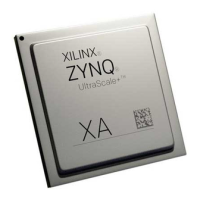RFSoC Data Converter Evaluation Tool User Guide 10
UG1287 (v2018.2) October 1, 2018 www.xilinx.com
Chapter 1: Introduction
commands received from the GUI, the Linux application performs various operations that
are described in Chapter 6, Software Architecture. Because a TCP socket is used to transfer
the data over Ethernet, it is possible to run the GUI on any machine connected to the
network (i.e., cloud).
The evaluation tool can be run in three separate modes:
Standalone DAC: In this mode, a pattern is generated using the GUI on the host
machine. This pattern is constantly replayed on the selected DAC channel. The output of
the DAC can be monitored on any standard external equipment, such as a spectrum
analyzer or oscilloscope.
Standalone ADC: In this mode, you generate an analog signal from external equipment,
and this signal is fed to ADC inputs. Digital output of the ADC can be analyzed on the
host machine using the GUI.
DAC to ADC Loopback: In this mode, the output of the DAC is looped back to the input
of ADC. In this way, you can generate a pattern on DAC from the GUI and can analyze the
same pattern on ADC output in the GUI. It is recommended to manage RF signal
conditioning well. Anti-aliasing filters are supplied in the ZCU111 development kit for
the existing RF line up of RFMC-XM500.
Note:
For system performance and limitations in various scenarios, see the ZCU111 RFSoC RF Data
Converter Evaluation Tool Getting Started Guide [Ref 4].
Components
• Evaluation platform
°
ZCU111 evaluation board
°
Daughter card (HW-FMC-XM500)
°
Cables and filters (see the Zynq UltraScale+ RFSoC ZCU111 Evaluation Kit Quick
Start Guide (XTP490) [Ref 5]
• Xilinx tools
°
Vivado® Design Suite 2018.2 [Ref 6]
°
Xilinx® Software Development Kit (XSDK) 2018.2 [Ref 7]
°
PetaLinux tools 2018.2 [Ref 8]
• Hardware interfaces and IP
°
RFDC
°
AXI DMA
°
DDR controller interface
°
AXI SmartConnect

